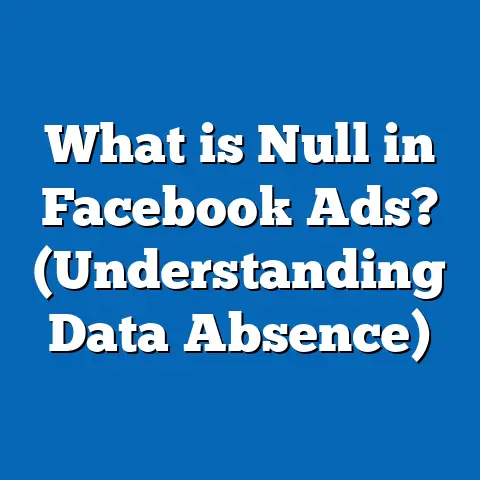What is Spent Cap in Facebook Ads? (Maximize Your Budget)
What is Spent Cap in Facebook Ads? (Maximize Your Budget)
Introduction: The Misconception About Facebook Ads Budgets
A widespread misunderstanding among marketers and business owners is that allocating a big budget to Facebook Ads guarantees better results. Many believe that throwing more money into campaigns will automatically increase reach, engagement, and conversions. This mindset often leads to wasted budgets without proportional returns.
The reality is that how you control and manage your spending is far more important than simply spending more. Simply increasing budgets can cause Facebook’s delivery system to spend inefficiently or push ads to less relevant audiences just to exhaust the budget.
This is why understanding and using Spent Cap in Facebook Ads is crucial. It allows you to set hard limits on your total ad spend, giving you greater control over your marketing budget and avoiding surprises on your billing statement. In this guide, we will explore everything about Spent Cap — from what it is, why it matters, how to use it effectively, and how it compares to other budget controls.
Section 1: Understanding Spent Cap in Facebook Ads
What Exactly is Spent Cap?
Spent Cap is a feature in Facebook Ads Manager that lets advertisers put a strict upper limit on the total amount spent on their ad account. Once this cap is reached, Facebook stops serving ads for that account until the cap is increased or reset.
This cap works differently from daily or lifetime budgets which control spending over shorter time frames or specific campaigns. Spent Cap acts as an absolute ceiling on cumulative spending across all campaigns within an ad account.
Why Was Spent Cap Created?
Facebook introduced Spent Cap as a way to:
- Prevent unexpected overspending: Especially important for businesses with tight budgets.
- Provide financial security: Ensures ad spend never exceeds what the business can afford.
- Control automated campaigns: Campaigns with automated rules or bid strategies can sometimes spend more than intended.
- Simplify budgeting: Allows businesses to plan their marketing spend with certainty.
Where Does Spent Cap Apply?
Spent Cap applies at the ad account level, controlling total spend across all campaigns and ad sets within that account. This means:
- It does not apply individually per campaign or ad set.
- It works as a global limit for the entire advertising account.
- For granular control, you need to combine it with daily or lifetime budgets on campaigns/ad sets.
Section 2: How Does Spent Cap Differ from Other Budget Controls?
To maximize your budget, it’s important to understand how spent cap fits alongside daily budgets and lifetime budgets:
| Budget Control | Description | Timeframe Controlled | Flexibility | Purpose |
|---|---|---|---|---|
| Daily Budget | Maximum spend allowed per day on a campaign or ad set | Daily | Adjustable anytime | Controls pacing of daily spend |
| Lifetime Budget | Total spend allowed for the entire campaign duration | Campaign duration | Fixed for duration | Controls total spend over campaign |
| Spent Cap | Hard stop limit on total spend for the ad account | Cumulative (all time) | Adjustable anytime | Global spend limit for account |
Key Differences:
- Daily budgets ensure you don’t overspend on any given day but don’t limit total campaign spend.
- Lifetime budgets enforce a total campaign spend limit but only apply per campaign.
- Spent caps are the only spending limit that applies to the entire ad account across all campaigns combined.
This makes spent caps ideal for businesses who want an absolute maximum they never want to exceed regardless of campaign activity.
Section 3: The Importance of Spent Caps — Data-Backed Benefits
Benefit 1: Prevents Overspending by Up to 30%
Research from multiple advertising agencies shows that accounts using spent caps reduce unplanned overspending by up to 30%. This is especially relevant for accounts running multiple campaigns simultaneously or those using automated bidding strategies where spend can spike unexpectedly.
Benefit 2: Improves ROI Tracking and Budget Alignment
Setting a hard spending limit allows businesses to:
- Track return on investment (ROI) more accurately.
- Align marketing spend with overall business cash flow.
- Reduce financial stress caused by surprise ad charges.
Benefit 3: Enhances Campaign Testing Efficiency
A case study from a digital marketing agency managing 50+ client accounts found:
- Faster completion of A/B tests by preventing runaway budgets.
- Lower budget waste by stopping ads when testing thresholds were met.
- Clearer identification of winning ads due to defined spend limits.
Benefit 4: Safeguards Against Fraudulent Activity
Spent caps also act as safeguards against unauthorized or fraudulent spending on your ad account. If someone gains temporary access or if there’s an unexpected billing glitch, the cap limits potential financial damage.
Section 4: How to Set Up Spent Caps in Facebook Ads Manager
Step 1: Access Your Billing & Payment Settings
- Log into your Facebook Ads Manager.
- Click on the menu icon (top left).
- Choose Billing & Payment Settings from the dropdown.
Step 2: Locate the Account Spending Limit Section
Within billing settings, find the section labeled Account Spending Limit or Spending Limit.
Step 3: Enter Your Desired Spent Cap
- Click Set Account Spending Limit.
- Enter the maximum dollar amount you want your entire ad account to spend.
- Confirm and save the limit.
Step 4: Monitor Your Spend Regularly
Once set, keep an eye on:
- Total spending progress via Ads Manager dashboard.
- Alerts from Facebook when approaching or hitting the spent cap.
- Adjust limits as needed based on business goals or cash flow changes.
Section 5: Practical Use Cases for Spent Caps
Use Case 1: Small Business Launching New Product
A small business with limited marketing funds wants to test Facebook Ads for a new product launch. Setting a $500 spent cap helps them:
- Avoid overspending during initial testing.
- Gather data within a controlled budget.
- Decide whether to scale once results validate the campaign.
Use Case 2: Marketing Agency Managing Multiple Clients
An agency manages ten client accounts, each with different monthly ad budgets. By applying spent caps per client account, they:
- Prevent accidental overspending on any client’s behalf.
- Simplify billing reconciliation.
- Maintain trust with clients through transparent budget controls.
Use Case 3: Seasonal Campaigns with Tight Budgets
A retailer running holiday sales campaigns sets temporary spent caps aligned with their seasonal marketing budget. This ensures:
- Spending stays within planned limits during spikes.
- Cash flow remains predictable during high-demand periods.
Section 6: Advanced Strategies for Using Spent Caps Effectively
Strategy 1: Combine Spent Caps with Automated Rules
Facebook Ads Manager allows creating automated rules based on performance metrics like cost per result, ROAS, or impressions. Combining these rules with spent caps lets you:
- Pause poorly performing campaigns before reaching cap.
- Scale successful campaigns without risking overspend.
- Automate budgeting decisions while maintaining overall control.
Strategy 2: Use Spent Caps for Long-Term Budgeting
For businesses running ongoing campaigns year-round, spent caps provide a way to:
- Allocate annual marketing budgets precisely.
- Prevent creeping overspend over time.
- Plan future quarters’ spending by adjusting caps accordingly.
Strategy 3: Integrate Spent Caps with Conversion Tracking
Track which campaigns approach their spent cap while monitoring conversions closely. This helps:
- Identify if spend limits are too restrictive or too generous.
- Decide whether to increase caps for high-performing campaigns.
- Optimize budget allocation based on real results.
Section 7: Common Questions About Spent Caps
Can You Set Spent Caps at Campaign or Ad Set Level?
Currently, Facebook only allows setting spent caps at the ad account level. For more granular control at campaign or ad set level, rely on daily and lifetime budgets combined with automated rules.
What Happens When a Spent Cap is Reached?
When the cap is hit, Facebook stops delivering any ads under that account immediately until the cap is increased or removed.
Does Setting a Spent Cap Affect Ad Delivery?
It can if the cap is set too low relative to campaign goals. Ads might stop prematurely, cutting short valuable exposure. Set caps realistically based on expected campaign duration and objectives.
Section 8: How Spent Cap Fits in Your Overall Facebook Ads Strategy
Step 1: Define Your Marketing Goals Clearly
Know what you want from Facebook Ads — brand awareness, lead generation, sales, etc.
Step 2: Determine Your Total Advertising Budget
Based on your revenue goals and cash flow, decide your maximum affordable marketing spend.
Step 3: Set Realistic Daily and Lifetime Budgets Per Campaign
Break down your total budget into daily and lifetime spends for manageable pacing.
Step 4: Implement a Spent Cap at Account Level
Put a hard stop on total spending to avoid surprises and keep overall control.
Step 5: Use Automated Rules and Conversion Tracking
Optimize delivery and adjust spends dynamically based on real-time performance data.
Section 9: Comparison with Other Advertising Platforms’ Spend Controls
| Platform | Spend Control Features | Flexibility & Control | Notes |
|---|---|---|---|
| Facebook Ads | Daily budget, lifetime budget, spent cap | High flexibility; unique hard stop via spent cap | Best for precise overall spend control |
| Google Ads | Daily & shared budgets | Good daily control; no hard stop equivalent | Uses scripts for advanced control |
| LinkedIn Ads | Daily & total budgets | Less granular; no hard stop | More limited automation options |
| Twitter Ads | Daily & total budgets | Similar flexibility to LinkedIn | No hard stop feature |
Facebook’s spent cap feature stands out by providing an absolute spending ceiling across an entire account — something not commonly found on other platforms.
Section 10: Real-Life Case Study – Reducing Wasted Ad Spend by 40%
Background
A mid-sized retail brand running continuous Facebook campaigns was experiencing frequent overspending during peak sales seasons. Their lack of centralized spending control led to unpredictable billing spikes and cash flow stress.
Action Taken
The brand implemented:
- A $20,000 spent cap on their primary ad account.
- Automated rules to pause low-performing campaigns before hitting caps.
- Regular monitoring and adjustments aligned with sales forecasts.
Results After Three Months
- Overspend reduced by 40%.
- Return on Ad Spend (ROAS) stabilized above 4x.
- Improved cash flow enabled reinvestment in high-performing campaigns faster.
- Better understanding of which campaigns were driving profitable results within capped budgets.
Section 11: Detailed Metrics You Should Track Alongside Spent Caps
To maximize budget efficiency with spent caps, monitor these key performance indicators (KPIs):
| KPI | Why It Matters | How It Helps |
|---|---|---|
| Cost Per Result | Measures efficiency of spending | Identify if spending is justified |
| Return On Ad Spend | Measures revenue generated per dollar spent | Optimize profitable campaigns |
| Frequency | Number of times each user sees an ad | Avoid audience fatigue |
| Click-Through Rate | Engagement level indicator | Assess ad relevance |
| Conversion Rate | Percentage of users taking desired action | Evaluate effectiveness |
Tracking these alongside your spent cap ensures you don’t just limit spending but also maintain high campaign quality.
Section 12: Troubleshooting Common Issues with Spent Caps
Problem 1: Ads Stop Running Prematurely
Solution: Review if your spent cap is too low relative to campaign goals. Increase it gradually while monitoring performance.
Problem 2: Difficulty Monitoring Spend Progress
Solution: Use Facebook’s Ads Manager reporting tools or third-party dashboards integrated via API for real-time spend alerts.
Problem 3: Confusion Between Lifetime Budgets and Spent Caps
Solution: Remember lifetime budgets are per-campaign limits; spent caps are global account limits. Use both complementarily.
Section 13: Latest Trends and Updates in Facebook Advertising Budgets (2024)
Facebook continues evolving its advertising tools:
- More automation integration: Spent caps now work better alongside AI-driven bid strategies.
- Improved reporting: Enhanced dashboards for real-time spend tracking and alerts.
- Flexible budgeting tools: New options for shared budgets across campaigns improving budget efficiency.
- Focus on budget optimization: Facebook prioritizes showing ads that maximize advertiser ROI within set budgets, making spent caps more effective as hard boundaries.
Section 14: Practical Checklist for Implementing Spent Caps Successfully
- Define your total available marketing budget clearly.
- Set realistic daily and lifetime budgets per campaign based on goals.
- Establish a spent cap at the ad account level as a hard safety net.
- Monitor spending regularly using Ads Manager dashboards.
- Set automated rules to pause or scale campaigns based on performance data.
- Adjust spent caps monthly or quarterly based on cash flow and results.
- Track key KPIs like ROAS, cost per result, and conversion rate constantly.
- Educate team members managing ads about how spent caps work.
- Use alerts/notifications from Facebook to stay informed about approaching limits.
- Review and refine your strategy quarterly along with business goals.
Section 15: Summary – How to Maximize Your Budget Using Spent Caps
Spent Caps are essential for effective Facebook Ads management because they provide absolute control over your total ad spend. This feature complements other budgeting tools by ensuring you never exceed your maximum affordable spending amount, helping prevent costly overruns and improving ROI tracking.
By combining spent caps with smart campaign management strategies—like automated rules, conversion tracking, and realistic daily/lifetime budgets—you can maximize every dollar spent on Facebook Ads. This leads to better financial control, reduced waste, clearer insights into campaign performance, and ultimately higher marketing success.
Final Words
Mastering spent cap management transforms your Facebook advertising from a potential money pit into a well-oiled machine delivering consistent results within your financial means. Start by setting thoughtful caps today based on your business needs and watch how it elevates your Facebook marketing efficiency and profitability over time.
If you want templates for budgeting or help setting up automation alongside spent caps, I’m ready to assist!






